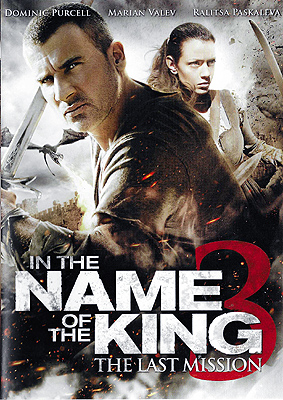 In the Name of the King 3: The Last Mission / In the Name of the King: The Last Mission (2013/2014) *
In the Name of the King 3: The Last Mission / In the Name of the King: The Last Mission (2013/2014) *
Okay, serious question: Why the fuck does In the Name of the King 3: The Last Mission exist? I mean, who asked for this? What market niche is there that could be filled only by yet a third In the Name of the King movie? And if such a niche could indeed be found, what could possess anyone to squander months of their one and only life making the stupid thing? Granted, you could parry at this point by saying, “You tell us— you’re the fool that watched it,” and fair enough. The thing is, though, that even I didn’t ask for another entry in this franchise. Even I, diseased as my tastes in film are, wasn’t sitting around thinking, “I really wish Uwe Boll would make another In the Name of the King movie.” No, all I did was to stumble upon the then-new trailer to The Last Mission while looking for information on In the Name of the King: Two Worlds, at which point I succumbed, as I so often do, to the siren song of an obviously terrible and insane idea— and even then I wasn’t entirely convinced that the film being advertised would ever actually be released! In the Name of the King 3 follows its immediate predecessor’s lead by stranding a modern-day badass in a pseudo-Medieval fantasy world, but instead of a retired special forces officer, this movie’s dimensionally displaced hero is a sadsack hit man! In the Name of the King 3: The Last Mission is a shitty ripoff of The Transporter that detours for most of its length through The Song of Lice and Mire.
The sadsack hit man is one Hazen Kaine (Dominic Purcell, from Silent Predators and Primeval)… and I’m sorry, but that simply isn’t a name. Kaine is an American expat (except when Purcell’s wild-ass Anglo-Australian accent comes roaring out at unexpected moments) living and working in Sofia, the Bulgarian capital. He was planning on hanging up his Glocks and retiring, but his longtime agent, Ayavlo (Marian Valev, of Death Race 4: Beyond Anarchy), has one last job for him first. Ayavlo is planning to ransom Sophie (Petra Gocheva) and Alys (Marina Dakova), the teenaged daughters of the Royal Family— which is puzzling, because Bulgaria hasn’t been a monarchy since 1946. Maybe there’s some kind of Habsburg situation at work, in which the throne itself may be gone, but a clan of pampered assholes is still running around boring anyone who’ll listen with claims that they’d be totally eligible to sit on it if it existed anymore? Regardless, Ayavlo can’t very well sell the girls back to their parents unless he has them in custody, so Kaine’s final assignment before fucking off to Malta or wherever with his lifetime’s worth of ill-gotten gains will be to kidnap the little princesses.
Alys and Sophie’s bodyguards couldn’t find their own asses with a GPS uplink, and Kaine has little trouble with the abduction itself. But while he’s herding the girls into the railyard shipping container which Ayavlo has designated as the handover site, he notices that one of them wears a medallion bearing a rather clumsy heptagonal figure. It’s exactly the same emblem that Hazen’s late wife (AHA! So that’s why he’s so persistently mopey!) got tattooed onto his arm as a gift many years ago. When questioned about it, the princess proclaims that her necklace is an amulet of protection— although it’s hard to see what good it’s doing her in that department just now. Kaine confiscates the charm in order to compare it with his tattoo while he waits for Ayavlo, then locks the hatch to the container behind him. No sooner does he bring the pendant into alignment with his arm, however, than a hole in the fabric of reality rips open before him, and sucks him right on through.
The land on the other side of the portal is ostensibly still Bulgaria, but it’s a non-specifically Medieval Bulgaria bearing no resemblance whatsoever to the one that once existed in our world. Those wishing to construct some meaningful continuity between all three films in this series are welcome to interpret that as deliberate evidence that this “Bulgaria” is one that coincidentally exists somewhere within the previous films’ Ehb, but it seems likelier to me that Boll and screenwriter Joel Ross just know nothing of the relevant cultural history, and would guess if you asked them that Tzar Simeon was an obscure character from the Planet of the Apes franchise. Then again, since the walled village outside of which Kaine now finds himself is under attack by a fire-breathing dragon, there’s obviously a limit to how heavily we should be weighting historicity anyway. It’s difficult to say just what makes the dragon abort the ruination of the town with so much of it still standing; certainly the 9mm slugs from Kaine’s pistol have very little apparent effect on it. But a weapon that spits fire impresses the hell out of the monster’s intended victims just the same, and the next thing Hazen knows, he’s being treated like a hero of prophecy.
The people most interested in Kaine are a pair of young women called Arabella (Code Red’s Ralitsa Paskalova) and Emeline (Daria Simeonova). These two are the daughters of a recently deposed and murdered king, and the leaders of a rebellion against the usurper, Tervin (who will also be played by Marian Valev when we meet him later on). Unsurprisingly, the symbol tattooed on Hazen’s forearm has profound significance for their dynasty, which goes even further toward elevating his assumed status than his “magical” armament. The sisters take him to meet first Ulrich the seer (Bashar Rahal, of Monster Ark and Shark Attack 3: Megalodon), and then their uncle, Tybalt (Nikolai Sotirov, from The Legend of Hercules and Hammerhead: Shark Frenzy), who will presumably assume the kingship in the event that their revolution succeeds. The trouble with all of this, from Arabella and Emeline’s point of view, is that Kaine is not at all interested in being a liberating hero, wanting only to go back home to collect his final payoff from Ayavlo. The trouble from Hazen’s point of view is that he dropped the amulet that brought him through time and/or space on the pavement in the railyard, so he can’t just repeat the trick of holding the thing up to his tattoo. Ulrich does know of one person, however, who possesses a similar talisman on Kaine’s current plane of reality. But since that person is Tervin, it looks like the only way for Hazen to get what he wants is to give Arabella and Emeline what they want first. Meanwhile, back in Sofia, the clock is ticking toward Ayavlo’s scheduled pickup of the kidnapped princesses, although it’s anybody’s guess how the passage of time there relates to the passage of time in the other world. And lest anyone forget, that dragon is still at large, ready to make mischief whenever the filmmakers start to feel the audience losing interest.
It’s much shorter to list the ways in which In the Name of the King 3 doesn’t disappoint. The inoperable dilapidation of post-communist Sofia gives the modern-day segments of the film a squalid authenticity that Uwe Boll could never have bought even during his tax-scam heyday, while the Balkan countryside and Byzantine castle locations combine to give the Medieval midsection a unique look and feel. Those are the good parts, and they’re pretty much the only good parts. Dominic Purcell is no substitute for Jason Statham or Dolph Lundgren as an action hero— or indeed as an action antihero. His Bulgarian costars speak English so poorly that their dialogue is often downright unintelligible, and by far the most baffling thing about The Last Mission is that 20th Century Fox didn’t insist on redubbing everyone but Purcell before agreeing to distribute it. The dragon is a major letdown after the surprisingly decent ones in the previous movie, and it’s the only supernatural creature this time around. And the digital cinematography looks like an eyestrain headache even if you somehow make it all the way through without actually getting one. Seriously, I’ve seen cell phone videos with better image quality, shot to a higher standard of professionalism.
But by far the most irksome of In the Name of the King 3’s failures is that it’s so goddamned desultory in both of its genre aspects, and in the way those aspects are combined. “The Transporter goes to Narnia” ought to be some unforgettably berserk bullshit, but the closest this movie ever comes to fulfilling that promise is a brief bit during the second climax when the dragon, having followed Hazen home, intervenes in the shootout that erupts between him and Ayavlo when the assassin gets second thoughts about completing his original mission. Kaine’s notional skill set as a modern-day hit man, so different from that of a Medieval man-at-arms, never has any impact on either tactics or technique during the battles against Tervin and his men. The fact that Tervin and Ayavlo are doppelgangers never means anything, and the recurrence of the magical glyph across two worlds serves only to set up a mechanism for shuttling Hazen between them. Boll and Ross can’t even be bothered to set up any parallels or resonances between the two pairs of princesses! The two halves of the lousy 21st-century Eurogangster movie just lie inertly on either side of the even lousier “Game of Thrones” wannabe, the juxtaposition never exerting any significant influence in either direction. In the Name of the King 3: The Last Mission doesn’t just suck; it sucks without any panache whatsoever.
Home Alphabetical Index Chronological Index Contact

